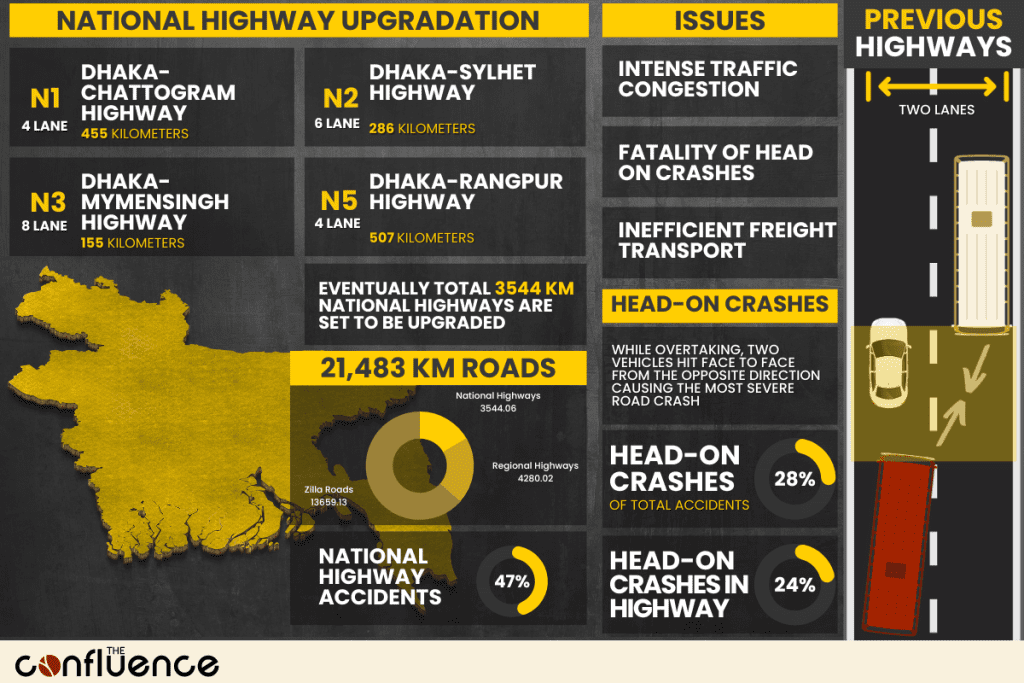Highways serve as the backbone of Bangladesh’s long-distance commute. The country is seeing an ever increasing number of vehicles every year. Even though Bangladesh is shifting towards expressways in the recent times, our highways should not be left behind.
Bangladesh, a nation of vibrant growth and progress, has an extensive road network consisting of 21,483 kilometers. These roads had been playing a vital role in facilitating passengers commute, goods transportation, and freight across the country. However, in response to the rapidly increasing number of vehicles, Bangladesh is ambitiously moving towards constructing expressways. The Bangabandhu Expressway from Jatrabari, Dhaka to Bhanga, Faridpur is already completely operational from 12 March 2020, connecting National Highway 8 to National Highway 4 and 5. The Dhaka Elevated Expressway is partially opened up. However, the existing national roads and highways require widening, some of which have already been widened, carving the way for improved infrastructure. This initiative is set to reform the landscape of connectivity and transportation.
Bangladeshi Road Network
Road Network (Kilometres)
Source: Roads and Highways
No Data Found
Within Bangladesh’s extensive twenty one thousand kilometer road network, the diversity of road types plays a crucial role. This network consists of 3,544.06 kilometers of national highways, 4,280.02 kilometers of regional highways, and a significant 13,659.13 kilometers of district or zilla roads.

The 3,544.06 kilometers of national highways serve as vital connectors that link the national capital to various divisional centers, old district headquarters, port cities, and international highways. These roadways are designated as national highways due to their national importance and strategic geographic positioning. The national highway network provides a lifeline for both commuters and the transport of goods, serving as an essential link between major cities and economic zones. These highways converge in the heart of the nation, at the capital, Dhaka, which acts as a central hub, making it convenient for connected districts to access this critical network. The concentration of national highways in and around Dhaka not only enhances accessibility within the country but also strengthens Bangladesh’s position as a central player in regional transportation and trade. These national highways represent a crucial component of the nation’s infrastructure, promoting economic growth and the efficient movement of people and goods, contributing to the overall development of Bangladesh.
Bottlenecks
Narrow national and regional highways have indeed inflicted multiple challenges on the country’s economy and road safety. These include severe traffic congestion, a higher occurrence of road accidents, and significant delays in the transportation of goods. These issues not only disrupt the smooth flow of traffic but also impact the overall economy by causing bottlenecks in the movement of people and goods, increasing the risk of accidents, and hindering timely deliveries. Addressing the widening and improvement of these highways is pivotal to alleviating these problems and ensuring safer, more efficient, and uninterrupted transportation throughout the nation.
Intense Traffic Congestion
The national highways in Bangladesh serve as the primary routes for intercity passenger buses. However, for many years, these crucial highways remained two-lane, which caused significant limitations on speed, caused congestion, and hindered overall efficiency. During special occasions like Eid and Pooja, when people travel to their hometowns, these two-lane highways would often succumb to long and intolerable traffic jams, stretching for kilometers, becoming a major challenge for both commuters and the efficient flow of traffic. The need for widening and upgrading these highways to meet the growing demands of a rapidly developing nation became increasingly evident.

Fatality of Head On Accidents
Road Crashes and Fatalities by Road Class (%)
Source: Roads and Highways
No Data Found
The inherent dangers of traveling on two-way two-lane highways, lacking a central divider, became increasingly evident due to simultaneous traffic flow in both directions with minimal margin for error. This configuration led to a significant number of accidents on these highways. A study revealed that national highways and regional highways were responsible for 47% and 14% of the total accidents, respectively. Furthermore, in conjunction with pedestrian accidents, head-on collisions accounted for 28% of the total accidents, with the absence of dividers and wider highway roads directly contributing to this alarming statistic. Head-on accidents often occurred when a vehicle attempted to overtake another by entering the opposing lane, resulting in direct collisions from the opposite direction, highlighting the urgent need for road safety improvements and the widening of these highways to enhance public safety.
Inefficient Freight Transport
The Land Transport sector has consistently contributed approximately 6-7% of the GDP in Bangladesh. Since the country’s independence, there has been a substantial expansion in the transportation sector. Freight transport has seen an average growth rate of about 8.2% per year, while passenger traffic has grown at an average rate of 8.4%. With the steady increase in the number of both freight and passenger vehicles, there has always been a pressing need to enhance infrastructure to accommodate this growth.
Sectoral Shares of GDP (%) at Constant Prices (Base Year 2005-06)
Source : BBS
No Data Found
The narrow roads had been causing significant challenges for transportation, impacting this sector’s contribution to GDP. Delayed delivery of goods, often due to road conditions, has been a recurring issue that affects the overall economy, highlighting the urgency of development in the Land Transport sector.
The condition of road infrastructure and quality of roads in Bangladesh has been a severe factor contributing to the fact that the country is lagging behind in global competitiveness. The quality of roads plays an important role in facilitating trade, commerce, and overall economic growth. Persistent issues such as narrow highways, congestion, and road safety concerns have hampered the Bangladesh’s ability to efficiently transport goods and people.
Opting for Upgradation
The government of Bangladesh has taken a development strategy that involves a comprehensive plan to upgrade the National Highways to a minimum of four lanes, alongside the development of other multi-modal transport facilities encompassing sea, river, and dry ports. This initiative targets to create an integrated high-speed mass transport system and advanced freight facilities to enhance the reliability, safety, and sustainability of the transport sector. This strategic approach not only resolve issues of congestion, road safety, and delays but also reflects a commitment to modernizing. Starting with the Dhaka-Chattogram highway, this initiative aims to create a safer, more efficient transportation network, improving access to economic hubs and enhancing domestic and international connectivity, thus boosting Bangladesh’s economic competitiveness on the global stage.
Dhaka-Chattogram Highway (N1)
The Dhaka-Chattogram highway, spanning 455 kilometers, is the linchpin of Bangladesh’s transportation network, serving as its economic backbone. An ongoing expansion project aims to convert the road into a four-lane highway from Daudkandi (Cumilla) to Chittagong, with provisions for future six-lane expansion. This development promises to significantly reduce travel time, cutting the journey from Dhaka to Chattogram by three hours, while also addressing traffic congestion, improving air quality, and facilitating trade, further cementing its crucial role in fostering economic growth and connectivity within Bangladesh.
Dhaka-Sylhet Highway (N2)
The Dhaka-Sylhet highway, spanning 286 kilometers from Kanchpur in Dhaka to Jaflong in Sylhet, is a crucial national route connecting the picturesque Sylhet region. This highway is essential for both tourism and the tea industry, contributing significantly to Bangladesh’s economy. The upcoming 200-kilometer six-lane upgrade will not only enhance domestic connectivity but also establish a key transportation link between Indian states Meghalaya and West Bengal via the Tamabil-Sylhet-Dhaka-Jashore route, facilitating trade and regional connectivity.
Dhaka-Mymensingh Highway (N3)
In a transformative endeavor, the Dhaka-Mymensingh highway is set to become an eight-lane expressway. This pioneering project will cover 87 kilometers from Joydebpur to Mymensingh, utilizing the existing four-lane road. This marks Bangladesh’s first eight-lane expressway, featuring four express lanes, two emergency lanes, and two service lanes.
Dhaka-Rangpur Highway (N5)
The Dhaka-Rangpur highway, serving as the gateway to North Bengal, stretches 507 kilometers from Dhaka to Thakurgaon via Rangpur and Bogura, making it the longest among national highways and a crucial contributor to the national economy. In the past, its poor condition hindered investment in North Bengal and trade between Bangladesh, India, and Nepal. The upcoming four-lane highway is set to revolutionize connectivity and trade in North Bengal, providing a significant boost to the region’s economic development.
0
Billion BDT
Along with these remarkable ones, construction for the other highways is expected to start soon. A total budget of 876.29 billion BDT has been allocated in the latest national budget to reinforce the national road connectivity.
About the Author

Hamim Mubtasim is the Brand Manager at The Confluence. He is currently pursuing his undergraduate studies at the Institute of Business Administration, University of Dhaka. A business student by choice and marketing geek by passion, he aspires to manage big brands someday.
